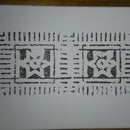Introduction: Wooden Deadbolt Lock
This is a wooden lock based on rural locks found in Appalachia as documented in the 6th volume of the FOXFIRE book series. Analog instructibles from some time ago. (and a neat story if you care to look it up)
This isn't fine woodworking, to channel the spirit of the old locks I left this project pretty rough.
I included some exact dimensions, but really your application and design will vary. The important thing is the basic concept, and from there can be modified to fit your needs.
Be safe first and foremost when working with your tools.
• WOOD:
5" X 11" X 1 3/4" solid: Lock body
7/16" thick plank: tumblers, bar, keys (from1/2" planed)
• TOOLS: Drill press, table saw, planer, chisel, forstner bits
Step 1: Layout
I used graph paper to lay out the concept and to try different configurations. This step was important to me in order understand the relationships between the parts in the assembly.
The tumblers are using gravity to do their job. The open side of the lock will be fastened against a wall or door which holds the assembly together. It should be noted that the key is needed in order to set the deadbolt as well as unlock it.
I added a standoff on the bottom of the tumblers to keep them from dropping to the bottom should the bar be removed. I also added a safety key on the opposing side in case you were to be locked in.
Step 2: Milling the Body
The first set of cuts are the channels that receive the tumblers.
Second, the channels for the key and the bar, and in my case the safety key.
tumbler paths: 1 5/8" deep X 1/2" wide X 8" long
key path: 15/16" deep X 1 3/16" wide path to path long
Bar path: same as key path but 1 9/16" wide
The rectangular slots need to be cut into the short sides. These should match the bolt and key channels
Step 3: Tumblers
The tumblers should be all cut at the same time to ensure that they are uniform The blanks should slide easily up and down in the channels with plenty of wiggle room to account for variations in the wood due to humidity etc. I used a planer to take down the tumblers and the key/bar blanks to better match the 1/2" forstner bit I was using. I chamfered all edges on the tumblers. This helps the wood items slide over each other when needed.
Step 4: Bolt/Keys
Once the tumblers are set, the bolt and keys can be made to fit. I made several keys at once to have a few spares.
Make sure the key and bar blanks slide freely in the lock body prior to cutting the teeth. Mark the teeth on the blanks and cut away.
The safety key could be a dowel or anything straight. No exact key is needed.
Again I knocked all the edges off l to form a leading chamfer to ease the interaction between moving parts.
Step 5: Full Assembly
Sorry for the photo overkill. Anything I typed seemed to muddy it up.
Tumblers are gravity driven so you need the key in order to set the bar. If you don't have the key, the first tumbler will not allow the bar to pass.
Step 6: Possible Feature
with a couple of short dowel slugs, it's possible to lock the bar in the lock while still having full travel. I was more interested in being able to remove the bar entirely so I didn't include this in the design.
Step 7: As Installed
When affixed from the back side hiding the workings, it just looks like a block of wood sitting on the shelf with some holes in it.
While it's not a secret lock, it will confound would be enterers, provided they aren't saw wielding of course.
This was a fun project. The most important step is wrapping your head around the mechanics of it. The 2D paper mockup was essential.
This is installed in a secret(ish) pocket door, the subject of one of my other instructables. its the reason that you don't see a jamb or a door. Its also why the safety key was designed in this fashion.

Runner Up in the
Safety Challenge











